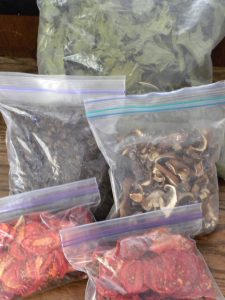
Peach Blossoms – a food source for pollinators in the spring, too!
Popping open home-canned peaches in January is… magic. A taste of summer in winter. This year I am taking extra pride in them because I finally met my long-time goal of growing them all organically here at home, as well as canning them myself.
Early-on in my canning adventures I realized what a great crop peaches were for me to focus on.

Picking Peaches
Peaches are delicious, one of my favorite fruits. When sliced and simmered in their own juices for hours they only get better. I gave up processed sugar when I was twenty-one, so finding natural ways to experience sweet is a goal of mine. A bowl of canned peaches with no added sweetener counts as dessert to me.
Since I wanted to ramp up fruit preserving with the goal of eating local year-round, peaches were a solid way to do that. The smaller fruits and berries took a lot of time to pick in any large amount. But I could go to an orchard and pick 100 pounds of peaches in an afternoon. Some orchards even sold “seconds” and “drops” all boxed up at a good price. While still work to process at home, it was even easier than hulling strawberries and I ended up with so much more.
Also, there were farms growing peaches around me. If you go much farther North, they don’t thrive, but we are still in peach country here so I can get them locally.

Canning Peaches
So, I started seriously canning peaches, with a goal of 75 quarts per year. I didn’t always end up with that much, but I often at least got close.
There was really just one problem with this whole plan. I could not get organically grown peaches and I knew that peaches are one of the most heavily sprayed fruits in the US. I was choosing local over organic, but I really wanted both! I asked every orchard I ever went to if they were considering organic methods but was consistently told that it wasn’t possible to grow peaches without sprays.

Our Lars Anderson Peach Tree
I guess I heard that insistent refrain as a challenge. Soon after we settled on a piece of land and began our own orchards, I planted peaches. I knew they might fail, that they might get diseases and pests and die quickly before ever giving fruit… but I wanted to try. I was actually so convinced that they probably wouldn’t do that well, that we didn’t prune them very much the first two years, thinking that they would grow slowly if at all.
Instead, our peaches took off, growing like weeds. In fact, one of our first trees grew so quickly before we could figure out how to best prune them that the main trunk snapped off one summer when it was heavy with fruit. Luckily we were able to cut it above the graft and it sprouted back fast, bearing again after just one year off.

Recovering Blushingstar Peach
The first three were planted here in 2015: a Blushingstar, a Lars Anderson and a Red Haven. It was the Blushingstar that grew so fast without enough pruning that the trunk broke in 2019 (the photo here shows the way the tree bounced back!). In 2016 I added a Starfire peach tree, a Contender in 2020 and another Contender in 2021.
We’ve been harvesting yearly since 2017, but my harvest record-keeping wasn’t great until 2018 so that’s when I can accurately start reporting. In 2018 I harvested 40# of peaches and in 2019 I harvested 219#. 2020 started with great blossoms and fruit set for the three bearing trees, but during the drought they dropped a lot of unripe fruit so we only brought in 53#.

Our Peaches, Waiting to be Canned
Then we come to this past summer, with 4 well-established trees and a break in the drought by July setting us up for a great harvest totalling 347.5#. Periodic canning days in August allowed me to put up 87 and ½ quarts, which I believe is my record of peaches canned in one year. (We also ate quite a few fresh!)

Our Red Haven Peach Tree
I do want to note that my organic peaches are often not aesthetically perfect. So, I really do understand the problem that commercial orchards face while customers care so much about how food looks rather than how it tastes or if it’s safe. The imperfections we see are not from disease at this point, but our life-affirming landscape means there are bugs and birds and squirrels and others passing through sampling the produce. I’m ok with that. This fruit is healthy, the taste is amazing and we got our fair share.
I’m sure not every year will be so successful, but I am daring to believe there will be other great seasons. I have even ordered three more trees for my 2022 planting, which I dream about while eating a bowl of goat’s milk yogurt topped with peaches and drizzled with maple syrup.

Our goat milk yogurt, topped with our canned peaches and maple syrup from our neighbor – a delicious local meal in the middle of winter!



















